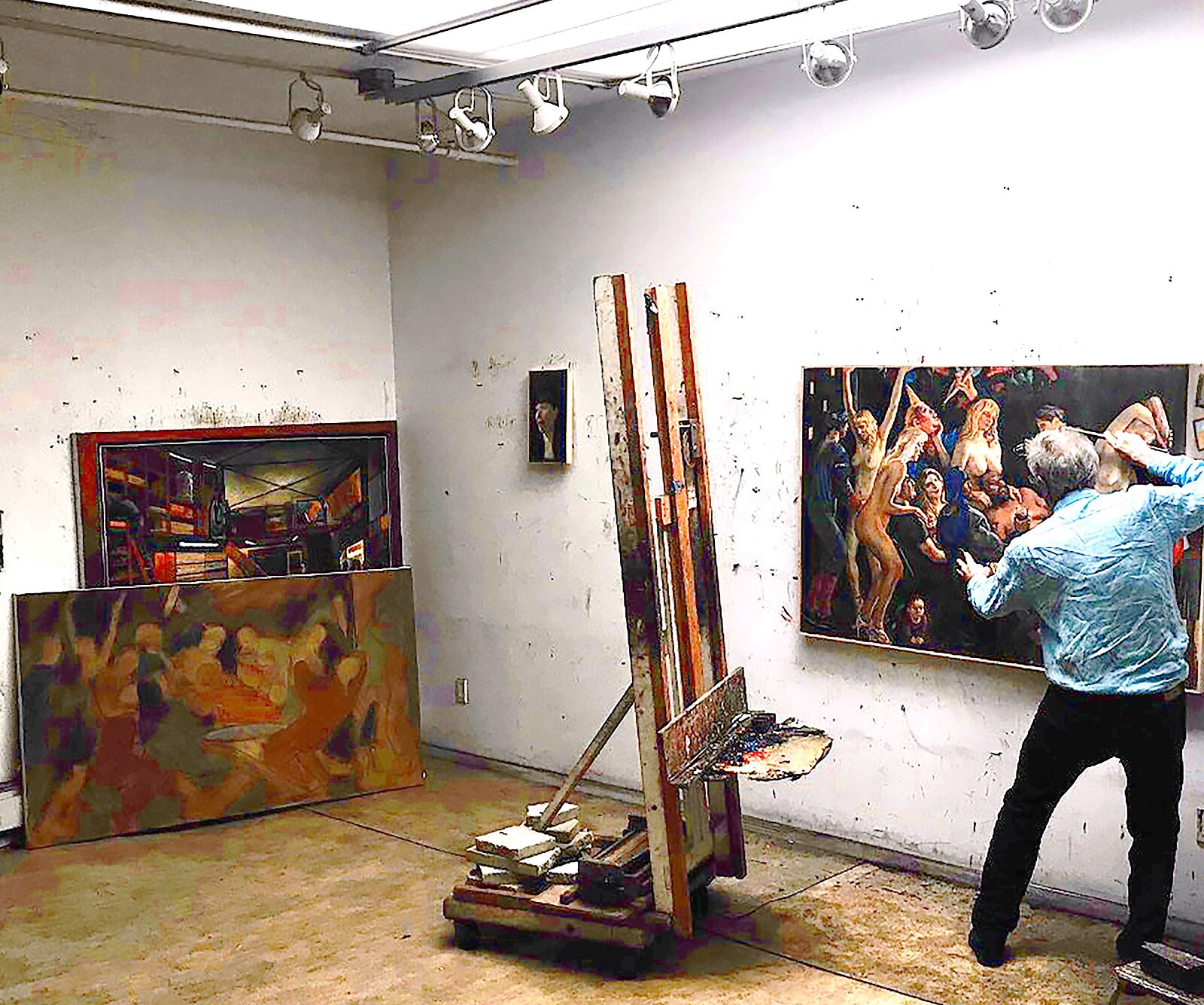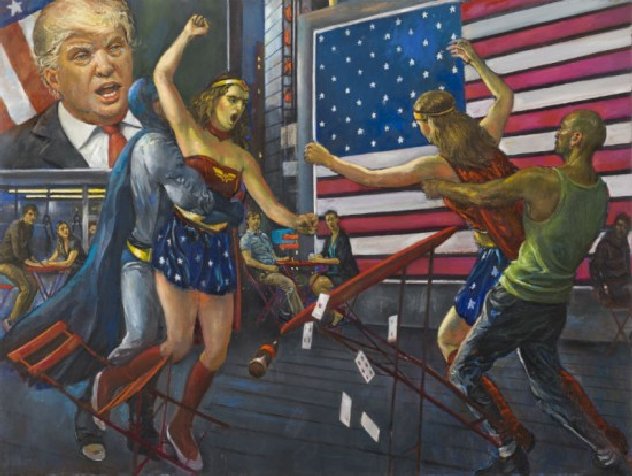“Art, whatever it takes”
The RomeArtProgram has made a series of interviews with Artists living in Italy, the USA & the UK to know their feelings and orientation during these times of emergency.
Don Perlis: a NY painter in NY.
Don Perlis is a Member of the National Academy – New York.
RomeArtProgram: Where do you live? And what is your background?
Don: Since the early sixties, I’ve lived in Tribeca. I was born in the Bronx to Russian Jewish immigrants, and educated in public schools. My first art training was at “The High School of Industrial Art” in Manhattan in a small building that was once a civil war hospital and located in midtown. There were Union soldiers buried in the basement. I wanted to be a magazine illustrator. Then I went for two years to NYC Community college to learn advertising art after being discouraged by my illustration teacher. I hated working at advertising agencies and would get regularly fired for making a mess. Between jobs I hung around MOMA, looked at a lot of painting, and took classes at the “Art Students League”. I learned anatomical structure as well as linear perspective. I decided to study art full time and chose the “School of Visual Arts”, it was the first year they had an art department and I didn’t learn much. That changed when I went to “Skowhegan School” in Maine. It was my first connection to serious dedicated artists. For me it was revelatory.
In your opinion is there a “creative method”?
Don: The only “creative method”I can think of is persistence. Like Churchill said, Never give up, Never, never, never, never, never, never!
The “lock down moment” can set you on the path of some important change(s) in your creativity and style…Has this happened to you?
Don: The time I remember that was most like now was when I was 25. I dug into my studio for 3 years learning to work exclusively from the model. I remained isolated until I was 28 and finally produced a terrific painting. A friend brought Marcia Tucker over and she recommended me to a curator at the Whitney who put four of my paintings into an important show. Then I got a call from Tom Hess and he gave my work a major article in “Art News”. The following year I had my first solo show at Graham Gallery where I showed with Edwin Dickinson, Alice Neel and Lennart Anderson.The eighties also was a period of social turmoil, and I made a series of paintings based on some disturbing events, like The Goetz shooting, the Bumpers killing and others. This resulted in a huge show at El Boheo on the lower East side as well as a video narrated by F. Murray Abraham. Recently, during the current Covid 19 crisis I’ve produced several works that are a breakthrough for me. I can say that because for the first time in my life I am making large and complex multi-figured compositions entirely from my head, and they’re really good. There is a group of them currently on view at one of the only galleries open now on the East coast, Greenkill in Kingston. The final one was my “Floyd” painting which marks another lockdown moment as it is a return to my “Social” paintings but with the difference of 30 or more years of practice.
What normally inspires you? Which is the most important inspirational source you have found in Rome?
Don: What normally inspires me can be a quick glance or a good story. I’m a representational painter and I’m visually motivated. I think in terms of form and possibility, that’s what excites me enough to want to design a painting. I’ve been in Rome many times in my life, twice staying at the American Academy for extended periods of time as well as other times. I always regretted not seeing Rome until I was 30 as it’s had such a profound influence on my thinking. It’s riches are so abundant that it would be tedious to start listing them. I’ve made many paintings of Rome as well. I’d get up in the dark and take a bus or walk to wherever I had planned a motif and work until it got too hot.
Is there a difference in working in Rome for an artist? What art medium do you prefer to work in?
Don: The difference is you’re not in your own studio and you have to “see” the environment. I work almost exclusively in oil on canvas except when I draw.
Specific events and historical conditions have a significant role in the creative process; how does this pandemic emergency affect the Arts?
Don: We live in turbulent times ,“ Interesting Times: as a Chinese philosopher says. I have responded to it. In many ways I’m grateful for the twin opportunities to hunker down in isolation and work hard as well as the rich subject matter suddenly available. First Trump, then a resurgence of Feminism, the rise of the Epstein Saga, the Covid Pandemic, then the Floyd Tragedy. You can’t make this stuff up. These events have led to some of the most powerful works of my life.
The crippling of the normal publicity machines have leveled the field and there is an increased opportunity to be “seen”.
How are you feeling at this difficult moment and what made you feel this way?…are you optimistic for the future?
Don: I’ve never been more happy as my work is flourishing and I don’t expect a hiatis to the madness.
What can Art contribute to history? Will “Art save us”?
Don: Most people especially in the USA don’t know or understand how to look at a painting. The best painting has always had a small elite audience and then spreads out. Unfortunately, the computer is now the main visual medium which is just another manifistation of TV. Art like literature doesn’t have an immediate effect, but people are influenced by it when they’re educated and it’s mostly educated people who influence the future so it has some import.
What is your most ambitious dream?…and the greatest sacrifice that you have made for your Art?
Don: Like many artists I want my work to last and be seen by future generations . Hopper said “ Most artists get forgotten 10 minutes after they’re dead”. The only sacrifice I’ve made is to keep working and put my work in front of everything and everybody in my life.
Recently, the artistic and cultural message of Italy and Rome was reemerging as a great “work in progress”, …is this your point of view?
Don: This implies a popular resurgence of the popularity of “Renaissance” art and classical painting. I don’t think there’s ever been a time in the West and since the Renaissance when interest has been lower than nowadays. It’s a pity that this is the case and its mostly due to poor education as well as the current hostility to anything “European” in the USA.
Which is your favorite Italian, or Roman, place(s) of art (Museum, Gallery, Monument…) ?
Don: It’s Parma , the birthplace of Correggio, Antonio Allegri. Consequently, Parma is where most of his major work is . Of course there are examples in Rome in the Borghese for instance but you have to go to Parma or to Dresden or Vienna to see him at his best.
Which period of Italian Art do you prefer? What is your favorite Italian work of art?
Don: I love Giotto, Masaccio, at the beginning, and then love all the stages and the final grand culmination in Venice. Italy has always had good artists before and after that until the current time. It would be torture to choose just one work.
How has Rome personally influenced you as an artist and a person?
Don: Rome has given me my foundation. Without it I wouldn’t be the painter that I am. Perspective, Anatomy, Pictorial Composition can only be learned by an intense study of works and which the most instructive examples are in Rome.
The shock of being face to face literally with some of the greatest minds that have ever lived and it all in close proximity can not have a more powerful effect on a young artist . It formed me and gave me the courage to spend the rest of my life trying to be of their company.
What’s your goal? What role does the artist have in society? Any final thoughts and advice?
Don: My goal is to make the best work I am capable of producing and to survive long enough to do it. Everyone’s life and goals are different but the only general advise I can offer is what I wrote earlier, NEVER give up. Persistence doesn’t guarantee success but it’s impossible without it.
www.donperlis.com
The RomeArtProgram is ready to bounce back!
_____________________
RomeArtProgram
#romeartprogram
Art-as-Power


